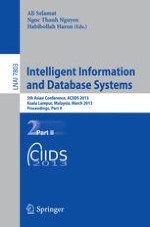The two-volume set LNAI 7802 and LNAI 7803 constitutes the refereed proceedings of the 5th Asian Conference on Intelligent Information and Database Systems, ACIIDS 2013, held in Kuala Lumpur, Malaysia in March 2013.
The 108 revised papers presented were carefully reviewed and selected from numerous submissions. The papers included are grouped into topical sections on: innovations in intelligent computation and applications; intelligent database systems; intelligent information systems; tools and applications; intelligent recommender systems; multiple modal approach to machine learning; engineering knowledge and semantic systems; computational biology and bioinformatics; computational intelligence; modeling and optimization techniques in information systems, database systems and industrial systems; intelligent supply chains; applied data mining for semantic Web; semantic Web and ontology; integration of information systems; and conceptual modeling in advanced database systems.
